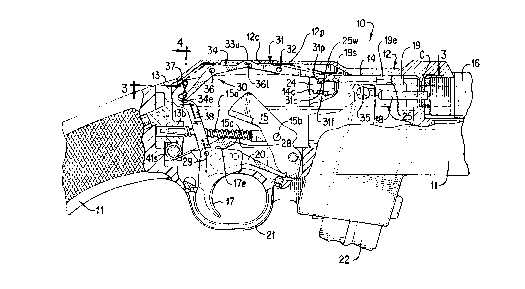Some of the information on this Web page has been provided by external sources. The Government of Canada is not responsible for the accuracy, reliability or currency of the information supplied by external sources. Users wishing to rely upon this information should consult directly with the source of the information. Content provided by external sources is not subject to official languages, privacy and accessibility requirements.
Any discrepancies in the text and image of the Claims and Abstract are due to differing posting times. Text of the Claims and Abstract are posted:
| (12) Patent: | (11) CA 2250503 |
|---|---|
| (54) English Title: | FIREARM'S BOLT FIRING PIN LOCKING SYSTEM |
| (54) French Title: | SYSTEME DE VERROUILLAGE DE PERCUTEUR ET DE CULASSE D'ARME A FEU |
| Status: | Expired and beyond the Period of Reversal |
| (51) International Patent Classification (IPC): |
|
|---|---|
| (72) Inventors : |
|
| (73) Owners : |
|
| (71) Applicants : |
|
| (74) Agent: | OSLER, HOSKIN & HARCOURT LLP |
| (74) Associate agent: | |
| (45) Issued: | 2005-01-25 |
| (86) PCT Filing Date: | 1997-03-18 |
| (87) Open to Public Inspection: | 1997-10-09 |
| Examination requested: | 2002-02-07 |
| Availability of licence: | N/A |
| Dedicated to the Public: | N/A |
| (25) Language of filing: | English |
| Patent Cooperation Treaty (PCT): | Yes |
|---|---|
| (86) PCT Filing Number: | PCT/US1997/004336 |
| (87) International Publication Number: | WO 1997037191 |
| (85) National Entry: | 1998-09-29 |
| (30) Application Priority Data: | ||||||
|---|---|---|---|---|---|---|
|
An autoloading firearm having a reciprocating bolt (14), a cocking lever and
firing pin (24) which bolt (14) and firing pin (24) are
locked by a locking lever (31) until the trigger (17) is pulled on until the
cocking lever of the bolt (14) is manually pulled back. A linkage
operably controlled by the trigger (17) causes the locking lever (31) to
unlock the bolt (14) and firing pin (24) when the trigger (17) is
pulled.
Arme à feu à chargement automatique comportant une culasse à va-et-vient (14), un levier d'armement et un percuteur (24). La culasse (14) et le percuteur (24) sont verrouillés par un levier de verrouillage (31) jusqu'à ce que la détente (17) soit tirée ou que le levier d'armement de la culasse (14) soit tiré en arrière manuellement. Grâce à une tringlerie commandée fonctionnellement par la détente (17), le levier de verrouillage (31) libère la culasse (14) et le percuteur (24) quand la détente (17) est tirée.
Note: Claims are shown in the official language in which they were submitted.
Note: Descriptions are shown in the official language in which they were submitted.

2024-08-01:As part of the Next Generation Patents (NGP) transition, the Canadian Patents Database (CPD) now contains a more detailed Event History, which replicates the Event Log of our new back-office solution.
Please note that "Inactive:" events refers to events no longer in use in our new back-office solution.
For a clearer understanding of the status of the application/patent presented on this page, the site Disclaimer , as well as the definitions for Patent , Event History , Maintenance Fee and Payment History should be consulted.
| Description | Date |
|---|---|
| Time Limit for Reversal Expired | 2006-03-20 |
| Letter Sent | 2005-03-18 |
| Grant by Issuance | 2005-01-25 |
| Inactive: Cover page published | 2005-01-24 |
| Inactive: Final fee received | 2004-11-09 |
| Pre-grant | 2004-11-09 |
| Notice of Allowance is Issued | 2004-05-11 |
| Letter Sent | 2004-05-11 |
| Notice of Allowance is Issued | 2004-05-11 |
| Inactive: Approved for allowance (AFA) | 2004-04-21 |
| Letter Sent | 2002-03-11 |
| Request for Examination Received | 2002-02-07 |
| Request for Examination Requirements Determined Compliant | 2002-02-07 |
| All Requirements for Examination Determined Compliant | 2002-02-07 |
| Inactive: IPC assigned | 1998-12-09 |
| Classification Modified | 1998-12-09 |
| Inactive: First IPC assigned | 1998-12-09 |
| Inactive: Notice - National entry - No RFE | 1998-11-26 |
| Application Received - PCT | 1998-11-24 |
| Application Published (Open to Public Inspection) | 1997-10-09 |
There is no abandonment history.
The last payment was received on 2004-03-18
Note : If the full payment has not been received on or before the date indicated, a further fee may be required which may be one of the following
Please refer to the CIPO Patent Fees web page to see all current fee amounts.
| Fee Type | Anniversary Year | Due Date | Paid Date |
|---|---|---|---|
| Basic national fee - standard | 1998-09-29 | ||
| Registration of a document | 1998-09-29 | ||
| MF (application, 2nd anniv.) - standard | 02 | 1999-03-18 | 1999-03-17 |
| MF (application, 3rd anniv.) - standard | 03 | 2000-03-20 | 2000-02-21 |
| MF (application, 4th anniv.) - standard | 04 | 2001-03-19 | 2001-02-19 |
| Request for examination - standard | 2002-02-07 | ||
| MF (application, 5th anniv.) - standard | 05 | 2002-03-18 | 2002-02-18 |
| MF (application, 6th anniv.) - standard | 06 | 2003-03-18 | 2003-03-03 |
| MF (application, 7th anniv.) - standard | 07 | 2004-03-18 | 2004-03-18 |
| Final fee - standard | 2004-11-09 |
Note: Records showing the ownership history in alphabetical order.
| Current Owners on Record |
|---|
| STURM, RUGER & COMPANY, INC. |
| Past Owners on Record |
|---|
| JAMES MCGARRY |
| MICHAEL SMISKO |
| WILLIAM B. RUGER |